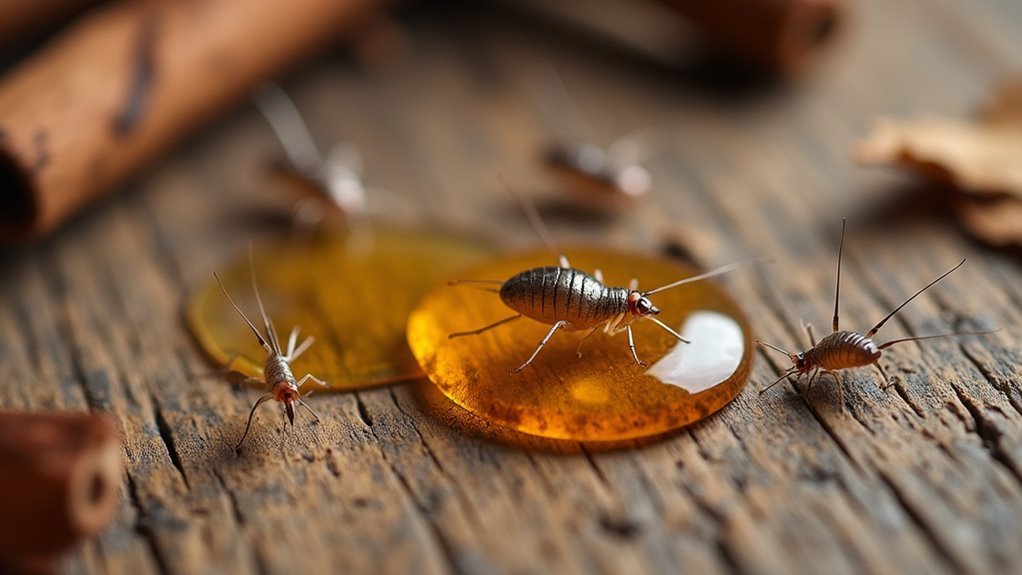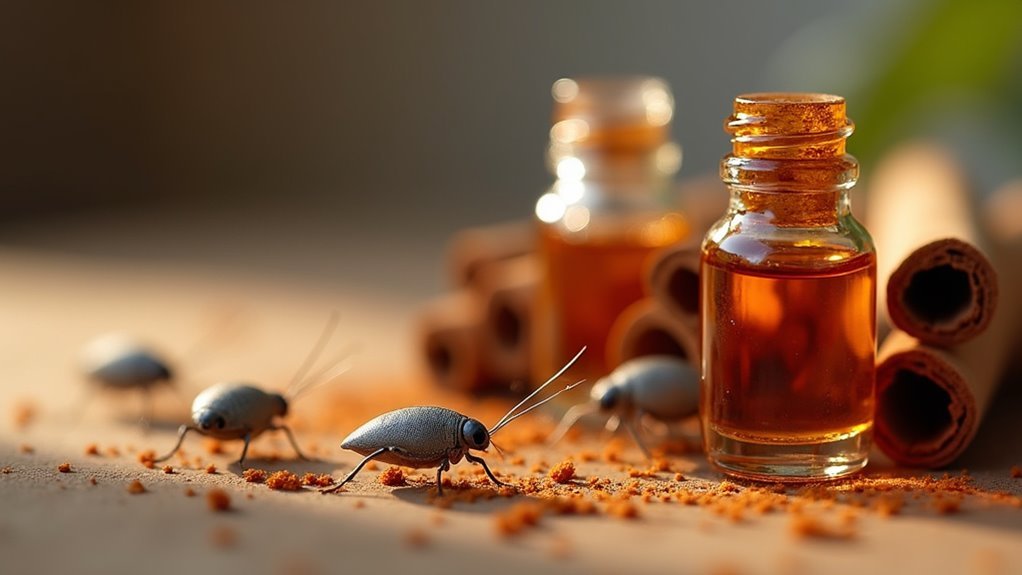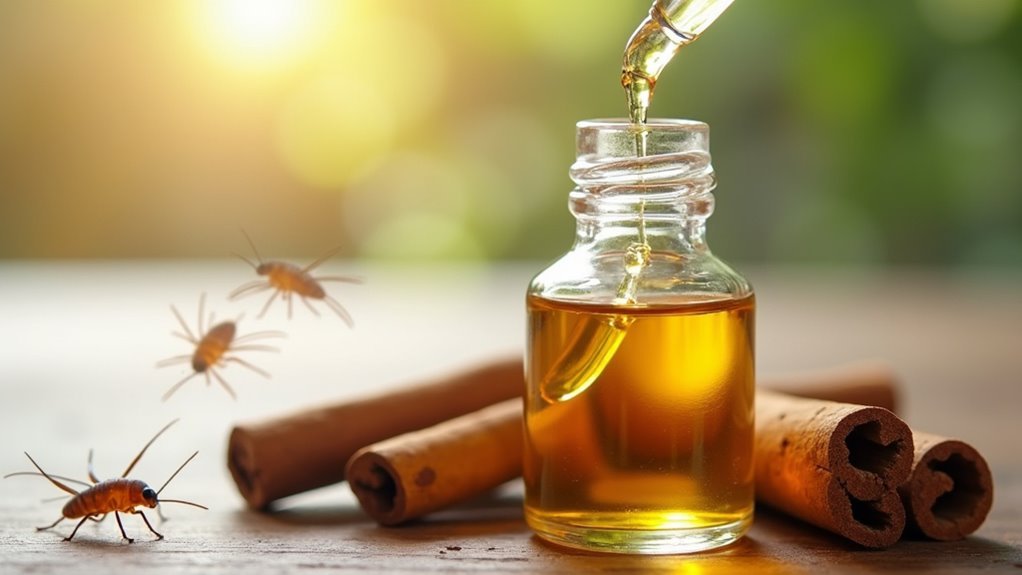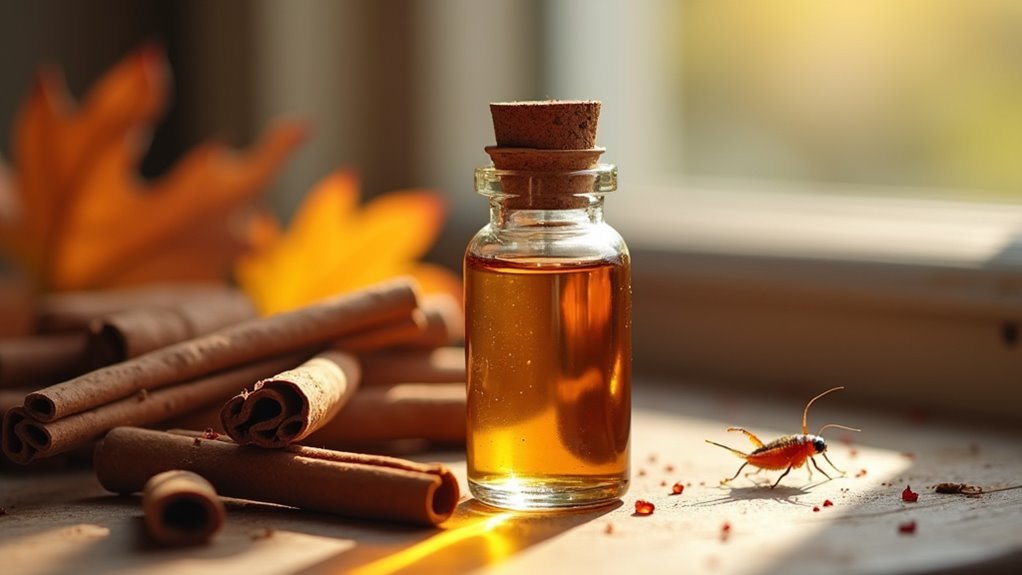Cinnamon oil’s active compound, cinnamaldehyde, disrupts silverfish sensory neurons and masks the pheromones they use for navigation and communication. This creates disorientation that forces these moisture-loving pests to abandon treated areas entirely. The oil also inhibits mold growth, eliminating their food sources, while forming a protective barrier they won’t cross. You’ll need proper concentration levels and strategic application methods to maximize these natural repellent properties.
Understanding Silverfish Behavior and Habitat Preferences

Before you can effectively combat silverfish infestations with cinnamon oil, you’ll need to understand what attracts these pests to your home in the first place.
Silverfish thrive in humid environments, making your bathrooms and kitchens prime targets for colonization. These nocturnal insects prefer dark, undisturbed spaces like basements, attics, and areas behind appliances where they won’t be disturbed during daylight hours.
What makes a silverfish infestation particularly problematic is their diet of carbohydrates, especially starches found in paper, glue, and fabrics.
If you’ve got clutter or paper goods stored in damp areas, you’re creating an ideal environment for them. With lifespans exceeding two years, these pests can establish large populations quickly, often indicating underlying moisture issues that require immediate attention.
The Science Behind Cinnamon Oil’s Repellent Properties
While many homeowners reach for harsh chemical pesticides, cinnamon oil offers a scientifically-backed natural alternative that targets silverfish through multiple biological mechanisms.
The key compound cinnamaldehyde disrupts silverfish sensory neurons, creating an environment they’ll actively avoid. You’ll find that cinnamon oil’s powerful aroma masks the pheromones silverfish rely on for communication and navigation, leaving them disoriented and unable to establish territories.
Cinnamaldehyde disrupts silverfish sensory neurons while masking their navigation pheromones, creating disorientation that forces them to abandon treated areas.
Beyond direct repulsion, cinnamon oil inhibits mold growth that silverfish feed on, eliminating their food sources. Its antimicrobial properties create cleaner environments that discourage breeding.
When you apply concentrated cinnamon oil, it forms an effective barrier that silverfish won’t cross, protecting your home and belongings through natural biological disruption rather than toxic chemicals.
How Cinnamon Oil’s Antimicrobial Action Affects Silverfish

Since silverfish depend heavily on mold and mildew as primary food sources, cinnamon oil’s potent antimicrobial properties create a direct assault on their survival system.
When you apply cinnamon oil to affected areas, you’re basically starving these pests by eliminating their preferred meals. The oil’s powerful compounds destroy fungal growth that silverfish typically feast on, forcing them to search elsewhere for sustenance.
You can extract this antimicrobial power from cinnamon sticks through distillation, concentrating the active compounds that make the treatment so effective.
This targeted approach doesn’t just repel silverfish temporarily—it removes their fundamental reason for inhabiting your space. By consistently treating moisture-prone areas where mold thrives, you’ll create an environment that’s fundamentally inhospitable to silverfish colonization and long-term survival.
Essential Oil Concentration Levels for Maximum Effectiveness
Getting the concentration right determines whether your cinnamon oil treatment will successfully eliminate silverfish or simply waste your time and money. You’ll need 10-15 drops of cinnamon essential oil per spray bottle of water to create an effective repellent solution. The mixture should emit a noticeable aroma that silverfish can’t tolerate.
| Concentration Level | Effectiveness | Safety Considerations |
|---|---|---|
| Low (5-9 drops) | Minimal repellent effect | Safest for pets/children |
| Ideal (10-15 drops) | Maximum effectiveness | Balanced safety profile |
| High (16+ drops) | Enhanced properties | Requires extra caution |
Higher concentrations boost repellent properties but consider household safety, especially around children and pets. You’ll need regular reapplication since the scent dissipates over time. Combine cinnamon with clove or peppermint essential oils for enhanced effectiveness while maintaining safe concentration levels.
Proper Application Methods for Cinnamon Oil Treatment

Once you’ve prepared your cinnamon oil solution with the proper concentration, strategic application becomes essential for eliminating silverfish from your home.
Focus your efforts on dark corners, baseboards, and areas where you’ve spotted silverfish activity. These locations create the perfect environment for infestations.
For hard-to-reach spots, use cotton swabs or paper towels soaked in cinnamon oil to guarantee thorough coverage. You can also incorporate the oil into your regular cleaning agents, allowing you to distribute its repellent scent while maintaining cleanliness throughout your home.
Remember that consistency matters most. Refresh your cinnamon oil applications every few days to maintain its potency and keep silverfish away effectively.
Target Areas Where Cinnamon Oil Works Best Against Silverfish
Understanding where silverfish congregate allows you to maximize cinnamon oil’s effectiveness by targeting their preferred hiding spots. These moisture-loving pests gravitate toward specific environments where they’ll feel most comfortable.
Focus your cinnamon oil applications on these target areas where silverfish commonly establish themselves:
| High-Priority Zones | Application Strategy |
|---|---|
| Bathrooms & basements | Apply generously in dark, damp corners |
| Kitchen cabinets & pantries | Create protective barriers around food storage |
| Room corners & baseboards | Establish perimeter defense lines |
You’ll achieve the best results by spraying diluted cinnamon oil directly into crevices and cracks where silverfish nest. Don’t forget to refresh your applications regularly, as consistent treatment maintains the protective barrier that keeps these unwanted visitors away from your living spaces.
Combining Cinnamon Oil With Other Natural Pest Control Methods
While cinnamon oil proves highly effective on its own, combining it with complementary natural pest control methods creates a multi-layered defense system that greatly boosts your silverfish elimination efforts.
Combining cinnamon oil with other natural methods creates a powerful multi-layered defense system that dramatically enhances silverfish elimination results.
These strategic combinations maximize your pest control results:
- Cinnamon oil + diatomaceous earth – The oil repels while diatomaceous earth dehydrates and kills silverfish on contact.
- Cinnamon oil + lavender essential oil – Creates pleasant-smelling protection that repels pests while adding calming aromatherapy benefits.
- Cinnamon oil + cedar shavings – Doubles the strong fragrances silverfish hate, forming powerful barriers against infestations.
- Cinnamon oil + silverfish traps – Attracts insects to traps while keeping them away from other home areas.
You’ll also find success incorporating cinnamon oil into homemade cleaning solutions, eliminating potential food sources while simultaneously repelling silverfish.
Duration and Frequency of Cinnamon Oil Applications
You’ll need to establish a consistent application schedule to maintain cinnamon oil’s effectiveness against silverfish.
The scent diminishes over time, so you must reapply the oil every few days to create a continuous barrier in infested areas.
Your reapplication frequency should increase after cleaning surfaces and may vary based on humidity levels and infestation severity in your environment.
Application Timing Schedule
Since cinnamon oil’s effectiveness relies on maintaining a consistent aromatic barrier, timing your applications correctly makes the difference between successful silverfish control and wasted effort.
Your application timing schedule should adapt to your specific situation and silverfish activity levels.
For established silverfish infestations, you’ll need aggressive weekly applications until activity drops considerably.
Once controlled, shift to maintenance mode with these guidelines:
- Apply every 1-2 weeks in infested areas for consistent repellent presence
- Reapply monthly in high-risk zones like kitchens and bathrooms for prevention
- Increase frequency to every few days during humid seasons when silverfish thrive
- Apply immediately after thorough cleaning to create protective barriers
This strategic timing guarantees continuous protection while maximizing your cinnamon oil’s repellent properties against silverfish.
Reapplication Frequency Guidelines
Because cinnamon oil’s volatile compounds gradually dissipate over time, you must establish a consistent reapplication schedule to maintain effective silverfish control.
These reapplication frequency guidelines recommend treating areas every 1-2 weeks under normal conditions. Focus on high-traffic zones like kitchens and bathrooms where silverfish bugs commonly appear, ensuring the scent remains potent.
If you’ve mixed cinnamon oil with cleaning products, reapply after each cleaning session to preserve its repellent properties.
When you spot silverfish bugs, increase applications to weekly intervals until they disappear completely.
Environmental factors greatly impact effectiveness—higher humidity levels require more frequent treatments.
Monitor treated areas regularly for pest activity and adjust your schedule accordingly to prevent silverfish bugs from returning to previously treated spaces.
Long-term Effectiveness Duration
Understanding the long-term effectiveness duration helps you plan a sustainable silverfish control strategy. Cinnamon oil’s repellent properties typically last 1-2 weeks before the scent diminishes and loses its deterrent power. You’ll need to refresh applications weekly to maintain consistent protection against silverfish invasions.
For maximum long-term effectiveness, consider these essential practices:
- Reapply cinnamon oil every 7 days to maintain strong aromatic barriers
- Combine treatments with humidity reduction and crack sealing
- Integrate applications into regular cleaning routines for enhanced results
- Monitor treated areas for scent strength and silverfish activity
The aromatic compounds that make cinnamon oil effective naturally fade over time, requiring consistent reapplication.
Safety Considerations When Using Cinnamon Oil Indoors
While cinnamon oil offers an effective natural solution for silverfish control, you’ll need to follow essential safety precautions to protect yourself, your family, and your pets.
| Safety Considerations | Action Required |
|---|---|
| Dilution | Mix with water before application |
| Ventilation | Guarantee adequate airflow during use |
| Storage | Keep away from children and pets |
| Testing | Perform patch test first |
Always dilute cinnamon oil with water to prevent skin irritation or allergic reactions. Maintain good ventilation to avoid respiratory discomfort from concentrated odors. Store the oil securely since ingestion can cause digestive upset in children and pets. Conduct a patch test on an inconspicuous area before widespread application. Follow manufacturer guidelines when combining with other cleaning agents to prevent harmful chemical interactions.
Monitoring Results and Adjusting Your Cinnamon Oil Strategy
You’ll need to track how well your cinnamon oil treatment works by monitoring silverfish activity in treated areas over time.
Keep detailed records of where you’ve applied the oil and note any changes in pest behavior or sighting frequency.
Based on your observations, you can then adjust how often you reapply the oil to maintain effective silverfish control.
Track Application Effectiveness
Once you’ve applied cinnamon oil to target areas, monitoring its effectiveness becomes essential for long-term silverfish control.
To track application effectiveness, you’ll need to systematically evaluate how well the treatment works against silverfish in your home.
Regular assessment involves checking treated areas for ongoing silverfish activity and observing any behavioral changes. Document your findings to identify patterns and determine ideal reapplication schedules.
Key indicators to monitor include:
- Changes in silverfish sightings or activity levels
- Longevity of cinnamon scent in treated areas
- New damage signs like fabric holes or yellow stains
- Home humidity levels affecting treatment success
Maintain detailed records of your observations, noting dates, locations, and effectiveness ratings.
This systematic approach helps you refine your strategy and determine when adjustments are necessary for sustained silverfish control.
Adjust Treatment Frequency
How often should you reapply cinnamon oil to maintain effective silverfish control?
You’ll need to adjust treatment frequency based on pest activity levels and environmental conditions. If silverfish persist after initial applications, increase frequency to every few days until activity decreases considerably.
Monitor humidity levels closely, as higher moisture requires more frequent treatments to maintain an inhospitable environment.
Track areas where silverfish activity occurs and rotate your application spots for thorough coverage. This prevents pests from finding refuge in untreated locations.
Combine your cinnamon oil strategy with other preventative measures like reducing clutter and sealing food sources.
Evaluate treated areas regularly and modify your schedule accordingly.
Frequently Asked Questions
How to Use Cinnamon to Repel Silverfish?
Mix 10-15 drops of cinnamon essential oil with water in a spray bottle. Apply to bathrooms, kitchens, and dark corners where silverfish hide. Refresh regularly and combine with cleaning agents for enhanced effectiveness.
How to Use Essential Oils to Repel Silverfish?
You’ll mix 10-15 drops of essential oils like cinnamon, lavender, or peppermint with water in spray bottles. Apply to silverfish-prone areas, dab concentrated oil on cotton swabs for corners, and refresh every few days.
What Scent Do Silverfish Hate the Most?
You’ll find that silverfish hate cinnamon’s scent the most. They can’t tolerate its intense, potent aroma and will actively avoid areas where you’ve applied cinnamon oil or powder.
What Is the Most Effective Silverfish Repellent?
You’ll find cinnamon oil is the most effective silverfish repellent. Its intense aroma creates an inhospitable environment, while its antimicrobial properties inhibit mold growth that attracts these pests naturally.
In Summary
You’ve learned how cinnamon oil’s potent compounds disrupt silverfish sensory systems and create an inhospitable environment they’ll actively avoid. You’ll get best results by applying concentrated solutions to their hiding spots and reapplying every few weeks. Don’t forget to combine it with moisture control and other natural repellents for thorough protection. You’re now equipped with effective, safe methods to keep your home silverfish-free using this powerful essential oil.





Leave a Reply